Abstract
IgG molecules are potential neuropharmaceuticals that may be used for therapeutic or diagnostic purposes. However, IgG molecules are excluded from entering brain, owing to a lack of transport of these plasma proteins through the brain capillary wall, or blood-brain barrier (BBB). The possibility of enhanced IgG delivery through the BBB by cationization of the proteins was explored in the present studies. Native bovine IgG molecules were cationized by covalent coupling of hexamethylenediamine and the isoelectric point was raised to greater than 10.7 based on isoelectric focusing studies. Native and cationized IgG molecules were radiolabeled with 125I and chloramine T. Cationized IgG, but not native IgG, was rapidly taken up by isolated bovine brain microvessels, which were used as an in vitro model system of the BBB. Cationized IgG binding was time and temperature dependent and was saturated by increasing concentrations of unlabeled cationized IgG (dissociation constant of the high-affinity binding site, 0.90 +/- 0.37 microM; Bmax, 1.4 +/- 0.4 nmol per mg of protein). In vivo studies documented enhanced brain uptake of 125I-labeled cationized IgG relative to [3H]albumin, and complete transcytosis of the 125I-labeled cationized IgG molecule through the BBB and into brain parenchyma was demonstrated by thaw-mount autoradiography of frozen sections of rat brain obtained after carotid arterial infusions of 125I-labeled cationized IgG. These studies demonstrate that cationization of IgG molecules greatly facilitates the transport of these plasma proteins through the BBB in vivo, and this process may provide a new strategy for IgG delivery through the BBB.
Full text
PDF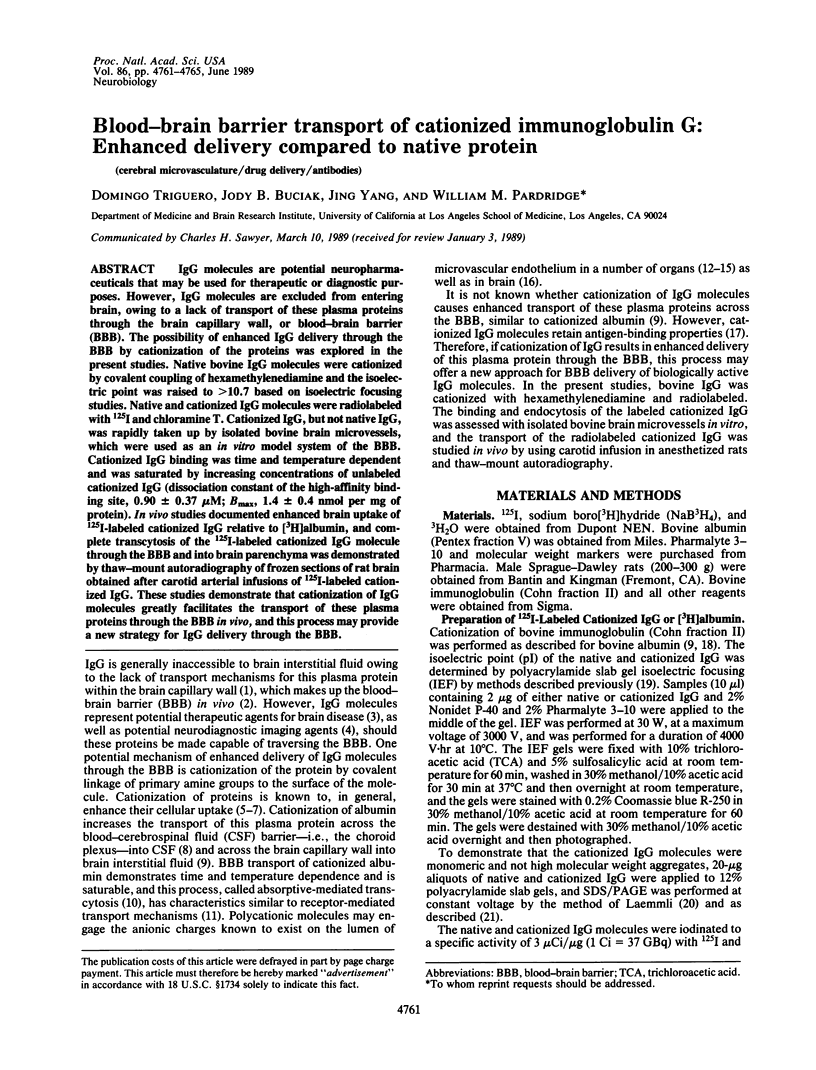
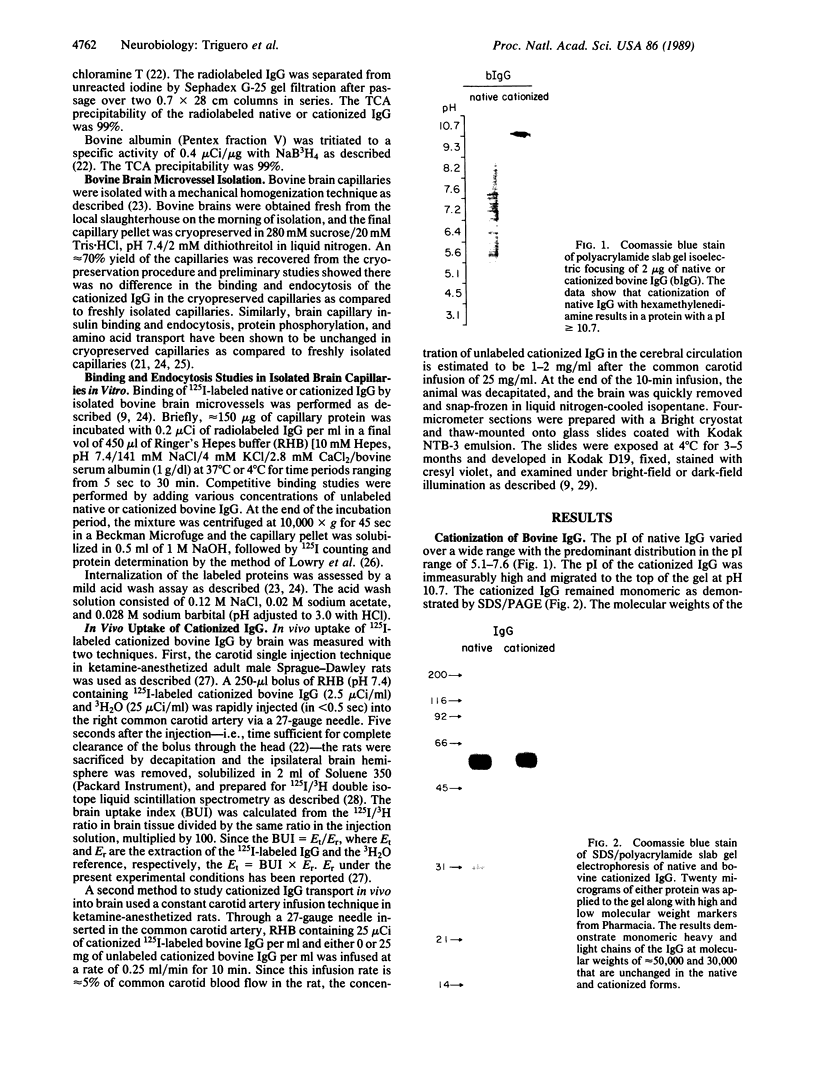
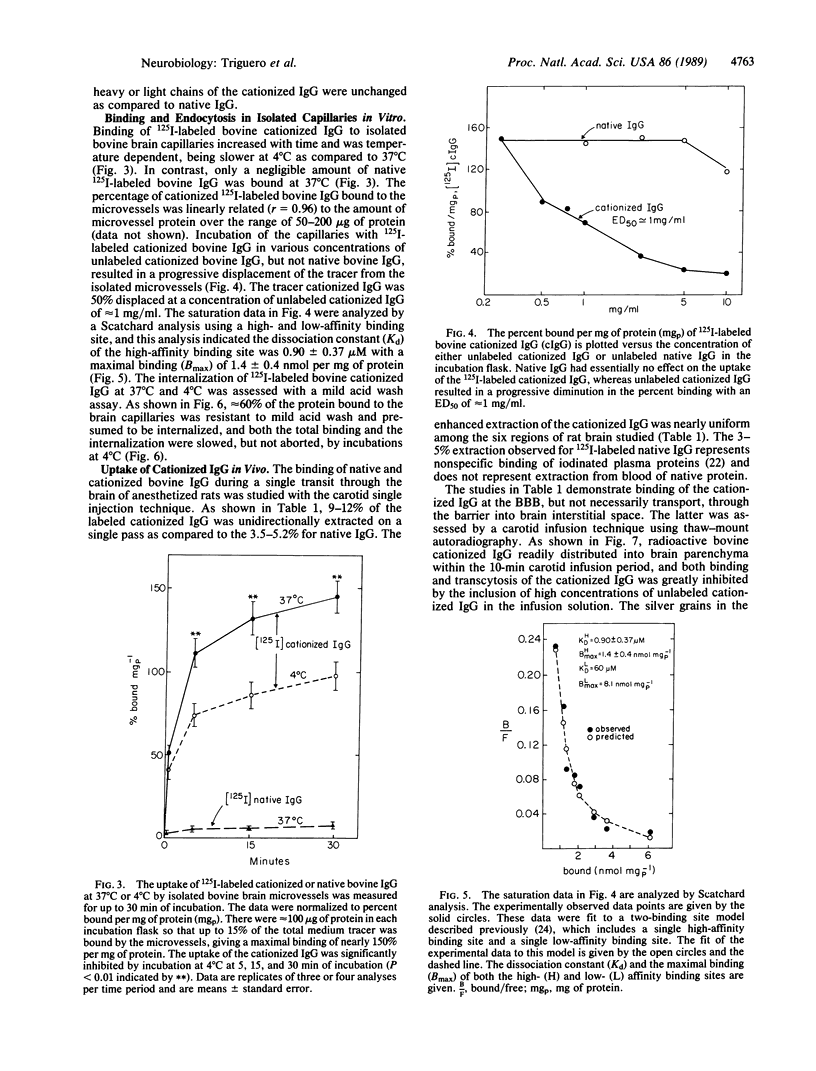
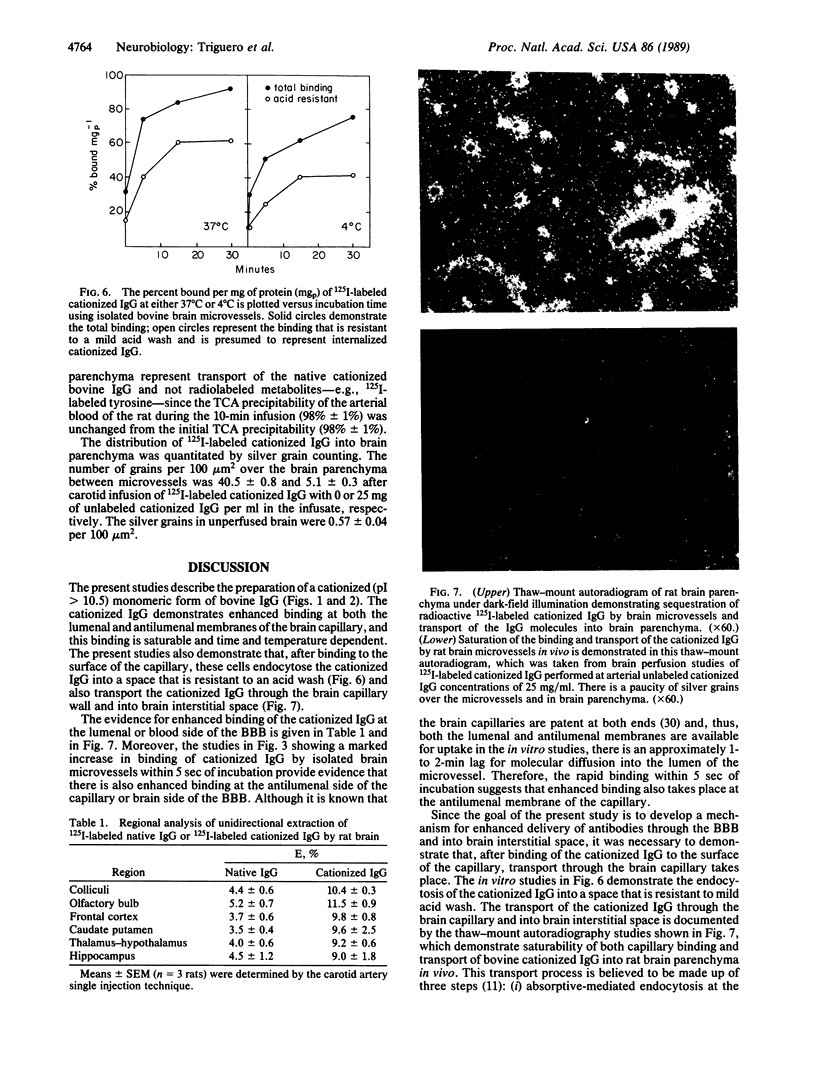
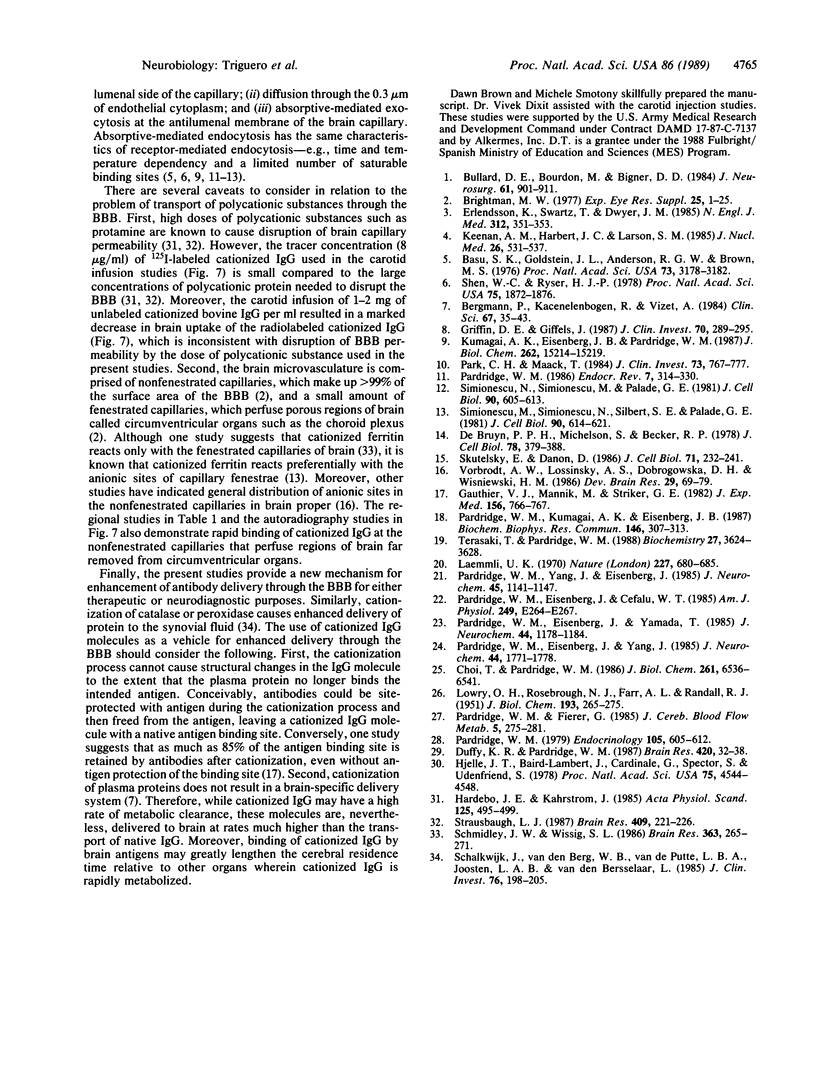
Images in this article
Selected References
These references are in PubMed. This may not be the complete list of references from this article.
- Basu S. K., Goldstein J. L., Anderson G. W., Brown M. S. Degradation of cationized low density lipoprotein and regulation of cholesterol metabolism in homozygous familial hypercholesterolemia fibroblasts. Proc Natl Acad Sci U S A. 1976 Sep;73(9):3178–3182. doi: 10.1073/pnas.73.9.3178. [DOI] [PMC free article] [PubMed] [Google Scholar]
- Bergmann P., Kacenelenbogen R., Vizet A. Plasma clearance, tissue distribution and catabolism of cationized albumins with increasing isoelectric points in the rat. Clin Sci (Lond) 1984 Jul;67(1):35–43. doi: 10.1042/cs0670035. [DOI] [PubMed] [Google Scholar]
- Brightman M. W. Morphology of blood-brain interfaces. Exp Eye Res. 1977;25 (Suppl):1–25. doi: 10.1016/s0014-4835(77)80008-0. [DOI] [PubMed] [Google Scholar]
- Bullard D. E., Bourdon M., Bigner D. D. Comparison of various methods for delivering radiolabeled monoclonal antibody to normal rat brain. J Neurosurg. 1984 Nov;61(5):901–911. doi: 10.3171/jns.1984.61.5.0901. [DOI] [PubMed] [Google Scholar]
- Choi T. B., Pardridge W. M. Phenylalanine transport at the human blood-brain barrier. Studies with isolated human brain capillaries. J Biol Chem. 1986 May 15;261(14):6536–6541. [PubMed] [Google Scholar]
- De Bruyn P. P., Michelson S., Becker R. P. Nonrandom distribution of sialic acid over the cell surface of bristle-coated endocytic vesicles of the sinusoidal endothelium cells. J Cell Biol. 1978 Aug;78(2):379–389. doi: 10.1083/jcb.78.2.379. [DOI] [PMC free article] [PubMed] [Google Scholar]
- Duffy K. R., Pardridge W. M. Blood-brain barrier transcytosis of insulin in developing rabbits. Brain Res. 1987 Sep 8;420(1):32–38. doi: 10.1016/0006-8993(87)90236-8. [DOI] [PubMed] [Google Scholar]
- Erlendsson K., Swartz T., Dwyer J. M. Successful reversal of echovirus encephalitis in X-linked hypogammaglobulinemia by intraventricular administration of immunoglobulin. N Engl J Med. 1985 Feb 7;312(6):351–353. doi: 10.1056/NEJM198502073120605. [DOI] [PubMed] [Google Scholar]
- Gauthier V. J., Mannik M., Striker G. E. Effect of cationized antibodies in performed immune complexes on deposition and persistence in renal glomeruli. J Exp Med. 1982 Sep 1;156(3):766–777. doi: 10.1084/jem.156.3.766. [DOI] [PMC free article] [PubMed] [Google Scholar]
- Griffin D. E., Giffels J. Study of protein characteristics that influence entry into the cerebrospinal fluid of normal mice and mice with encephalitis. J Clin Invest. 1982 Aug;70(2):289–295. doi: 10.1172/JCI110616. [DOI] [PMC free article] [PubMed] [Google Scholar]
- Hardebo J. E., Kåhrström J. Endothelial negative surface charge areas and blood-brain barrier function. Acta Physiol Scand. 1985 Nov;125(3):495–499. doi: 10.1111/j.1748-1716.1985.tb07746.x. [DOI] [PubMed] [Google Scholar]
- Hjelle J. T., Baird-Lambert J., Cardinale G., Specor S., Udenfriend S. Isolated microvessels: the blood-brain barrier in vitro. Proc Natl Acad Sci U S A. 1978 Sep;75(9):4544–4548. doi: 10.1073/pnas.75.9.4544. [DOI] [PMC free article] [PubMed] [Google Scholar]
- Keenan A. M., Harbert J. C., Larson S. M. Monoclonal antibodies in nuclear medicine. J Nucl Med. 1985 May;26(5):531–537. [PubMed] [Google Scholar]
- Kumagai A. K., Eisenberg J. B., Pardridge W. M. Absorptive-mediated endocytosis of cationized albumin and a beta-endorphin-cationized albumin chimeric peptide by isolated brain capillaries. Model system of blood-brain barrier transport. J Biol Chem. 1987 Nov 5;262(31):15214–15219. [PubMed] [Google Scholar]
- LOWRY O. H., ROSEBROUGH N. J., FARR A. L., RANDALL R. J. Protein measurement with the Folin phenol reagent. J Biol Chem. 1951 Nov;193(1):265–275. [PubMed] [Google Scholar]
- Laemmli U. K. Cleavage of structural proteins during the assembly of the head of bacteriophage T4. Nature. 1970 Aug 15;227(5259):680–685. doi: 10.1038/227680a0. [DOI] [PubMed] [Google Scholar]
- Pardridge W. M. Carrier-mediated transport of thyroid hormones through the rat blood-brain barrier: primary role of albumin-bound hormone. Endocrinology. 1979 Sep;105(3):605–612. doi: 10.1210/endo-105-3-605. [DOI] [PubMed] [Google Scholar]
- Pardridge W. M., Eisenberg J., Cefalu W. T. Absence of albumin receptor on brain capillaries in vivo or in vitro. Am J Physiol. 1985 Sep;249(3 Pt 1):E264–E267. doi: 10.1152/ajpendo.1985.249.3.E264. [DOI] [PubMed] [Google Scholar]
- Pardridge W. M., Eisenberg J., Yamada T. Rapid sequestration and degradation of somatostatin analogues by isolated brain microvessels. J Neurochem. 1985 Apr;44(4):1178–1184. doi: 10.1111/j.1471-4159.1985.tb08741.x. [DOI] [PubMed] [Google Scholar]
- Pardridge W. M., Eisenberg J., Yang J. Human blood-brain barrier insulin receptor. J Neurochem. 1985 Jun;44(6):1771–1778. doi: 10.1111/j.1471-4159.1985.tb07167.x. [DOI] [PubMed] [Google Scholar]
- Pardridge W. M., Fierer G. Blood-brain barrier transport of butanol and water relative to N-isopropyl-p-iodoamphetamine as the internal reference. J Cereb Blood Flow Metab. 1985 Jun;5(2):275–281. doi: 10.1038/jcbfm.1985.35. [DOI] [PubMed] [Google Scholar]
- Pardridge W. M., Kumagai A. K., Eisenberg J. B. Chimeric peptides as a vehicle for peptide pharmaceutical delivery through the blood-brain barrier. Biochem Biophys Res Commun. 1987 Jul 15;146(1):307–313. doi: 10.1016/0006-291x(87)90726-1. [DOI] [PubMed] [Google Scholar]
- Pardridge W. M. Receptor-mediated peptide transport through the blood-brain barrier. Endocr Rev. 1986 Aug;7(3):314–330. doi: 10.1210/edrv-7-3-314. [DOI] [PubMed] [Google Scholar]
- Pardridge W. M., Yang J., Eisenberg J. Blood-brain barrier protein phosphorylation and dephosphorylation. J Neurochem. 1985 Oct;45(4):1141–1147. doi: 10.1111/j.1471-4159.1985.tb05534.x. [DOI] [PubMed] [Google Scholar]
- Park C. H., Maack T. Albumin absorption and catabolism by isolated perfused proximal convoluted tubules of the rabbit. J Clin Invest. 1984 Mar;73(3):767–777. doi: 10.1172/JCI111270. [DOI] [PMC free article] [PubMed] [Google Scholar]
- Schalkwijk J., van den Berg W. B., van de Putte L. B., Joosten L. A., van den Bersselaar L. Cationization of catalase, peroxidase, and superoxide dismutase. Effect of improved intraarticular retention on experimental arthritis in mice. J Clin Invest. 1985 Jul;76(1):198–205. doi: 10.1172/JCI111946. [DOI] [PMC free article] [PubMed] [Google Scholar]
- Schmidley J. W., Wissig S. L. Anionic sites on the luminal surface of fenestrated and continuous capillaries of the CNS. Brain Res. 1986 Jan 22;363(2):265–271. doi: 10.1016/0006-8993(86)91011-5. [DOI] [PubMed] [Google Scholar]
- Shen W. C., Ryser H. J. Conjugation of poly-L-lysine to albumin and horseradish peroxidase: a novel method of enhancing the cellular uptake of proteins. Proc Natl Acad Sci U S A. 1978 Apr;75(4):1872–1876. doi: 10.1073/pnas.75.4.1872. [DOI] [PMC free article] [PubMed] [Google Scholar]
- Simionescu M., Simionescu N., Silbert J. E., Palade G. E. Differentiated microdomains on the luminal surface of the capillary endothelium. II. Partial characterization of their anionic sites. J Cell Biol. 1981 Sep;90(3):614–621. doi: 10.1083/jcb.90.3.614. [DOI] [PMC free article] [PubMed] [Google Scholar]
- Simionescu N., Simionescu M., Palade G. E. Differentiated microdomains on the luminal surface of the capillary endothelium. I. Preferential distribution of anionic sites. J Cell Biol. 1981 Sep;90(3):605–613. doi: 10.1083/jcb.90.3.605. [DOI] [PMC free article] [PubMed] [Google Scholar]
- Skutelsky E., Danon D. Redistribution of surface anionic sites on the luminal front of blood vessel endothelium after interaction with polycationic ligand. J Cell Biol. 1976 Oct;71(1):232–241. doi: 10.1083/jcb.71.1.232. [DOI] [PMC free article] [PubMed] [Google Scholar]
- Strausbaugh L. J. Intracarotid infusions of protamine sulfate disrupt the blood-brain barrier of rabbits. Brain Res. 1987 Apr 21;409(2):221–226. doi: 10.1016/0006-8993(87)90705-0. [DOI] [PubMed] [Google Scholar]
- Terasaki T., Pardridge W. M. Differential binding of thyroxine and triiodothyronine to acidic isoforms of thyroid hormone binding globulin in human serum. Biochemistry. 1988 May 17;27(10):3624–3628. doi: 10.1021/bi00410a015. [DOI] [PubMed] [Google Scholar]
- Vorbrodt A. W., Lossinsky A. S., Dobrogowska D. H., Wisniewski H. M. Distribution of anionic sites and glycoconjugates on the endothelial surfaces of the developing blood-brain barrier. Brain Res. 1986 Sep;394(1):69–79. doi: 10.1016/0165-3806(86)90083-0. [DOI] [PubMed] [Google Scholar]








